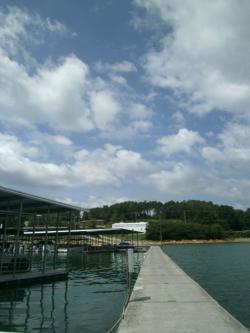Summertime fishing during my pre-teen years was always fantastic – whether I caught anything or not. From fishing for tiny cats and bream in the branch below my house to riding my bicycle to local farm ponds to try to catch bass, I fished almost every day.
Dearing branch provided some of my early learning experiences about fish behavior. When we were not damming it up or swimming in it, we fished. In a small branch you get up close and personal with the fish. I could watch how they used stumps, limbs in the water, current and other structure to hide and get food. Fish in big lakes act much the same way, just on a large scale. And hopefully, the fish are larger also!
I made my own “flies” for fishing the branch. It was quite a thrill the first time I got a six inch branch minnow to hit one of my creations of chicken feathers and sewing thread. I am sure the action of making it vibrate on the top of the water like a fallen insect was more important than the way it looked, but it worked. I thought I was really an artist, but found I needed bought lures to catch bass, my favorite.
To this day my bass boat is loaded with way more tackle than a dozen people could use in a week. One of my first tackle boxes – and I still have it – was a huge Old Pal box about two feet long. My folks got me a basket for my bicycle one Christmas and had to look all over Augusta to find one big enough to hold my tackle box.
With my tackle box in the basket and my rod and reel across the handlebars, I was ready to go to any pond within three or four miles. If I caught any fish they dangled on a stringer from one handlebar on the way home. I hardly ever went alone, my two friends and I traveled in a pack when we went fishing. That added to the fun.
I always had a few hooks, some line and a couple of sinkers and corks in a little box in my pocket. With my trusty – or maybe rusty – pocket knife I could cut a limb and be fishing in minutes. If there was a cane patch nearby I was in heaven with a real cane pole!
One summer my folks rented a cabin at Vogel State Park for a week. I could not wait to get to the clear mountain stream full of trout and try out my flies. I was eight years old and I knew those rainbows I had read about would just eat up my creation. How wrong I was!
After a couple of fruitless days of fishing the stream in front of the cabin and catching nothing, even with the live worms I had given in and tried, I decided the lake a mile or so downstream was where the fish were hiding. I also thought I needed to be there at the crack of dawn to catch them. I swear I told my folks I was going fishing early the next morning. I think they just didn’t remember with all the vacation excitement, but they were quite relieved when they found me mid-morning, sitting on a rental boat tied to the bank at the marina, catching tiny bream and bass on my earthworms and cut pole.
I had gotten up before anyone else and walked to the lake to fish. My parents found me when they asked a couple of teenage girls out walking around if they had seen a lost child. They told them of the “Huckleberry Finn” they had seen – barefoot but wearing a straw hat, sitting on the boat with a tree branch pole catching fish.
They didn’t get too mad. As a matter of fact, my mom told me years later that she didn’t worry about me as long as I was fishing. She thought a guardian angel watched over kids out trying to catch fish. They let me grow up pretty wild, and I thank them for it.




